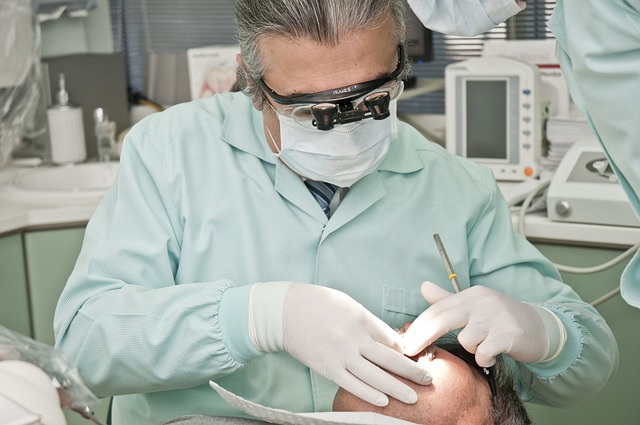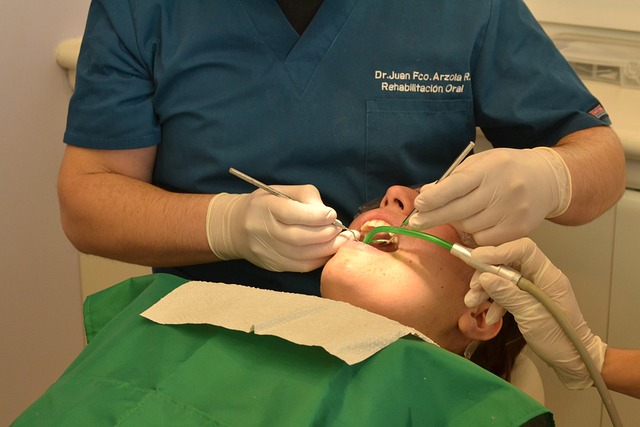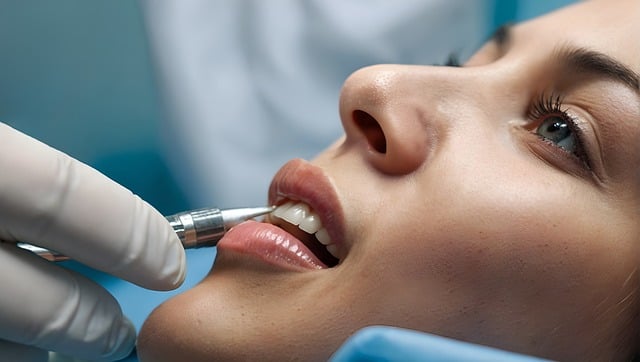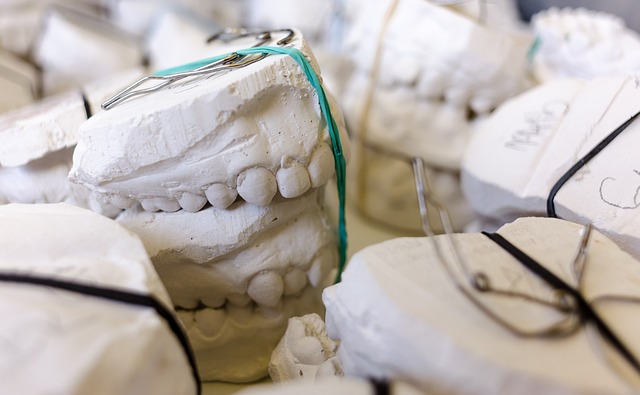To effectively prevent and manage dental caries, it's crucial to understand how acid produced by oral bacteria from sugars and starches erodes tooth enamel, leading to cavities. Regular brushing with fluoride toothpaste, flossing, and professional cleanings are key prevention strategies, alongside early detection through routine check-ups. Symptoms of caries include visible decay, tooth pain, or sensitivity to temperature and sweetness. In Oxford, teeth straightening with clear aligners, such as those from brands like Invisalign, offers a discreet solution for dental aesthetics that can also improve oral hygiene and potentially reduce the risk of caries by facilitating better access for brushing and flossing. Dietary changes to limit sugary and acidic foods, along with calcium and vitamin D supplements, support tooth health. Professional dental visits ensure timely treatment and monitoring. Advanced diagnostics and clear aligner treatments in Oxford are highlighted for their effectiveness in dental care, offering both cosmetic and functional benefits by improving tooth alignment and promoting overall oral health. This comprehensive approach integrates diet, personal hygiene, and professional care to maintain healthy teeth and gums, with clear aligners from Oxford being a standout option for those seeking aesthetic improvements alongside dental health enhancements.
When it comes to oral health, understanding and addressing dental caries, commonly known as tooth decay, is paramount. This article delves into the intricacies of tooth decay, from its causes and symptoms to its progressive stages. We will explore the critical role of professional dental assessments in accurately diagnosing decay, ensuring timely and effective treatment. From fillings and crowns to root canals, we will examine the various treatment options available. Additionally, we will highlight preventative measures, emphasizing diet, oral hygiene, and the benefits of fluoride use. Of particular interest is how teeth straightening with clear aligners in Oxford contributes to overall oral health, a topic that merits close examination. Join us as we navigate the complexities of maintaining healthy teeth and gums.
- Understanding Dental Caries and Tooth Decay: Causes, Symptoms, and Progression
- The Role of Professional Dental Assessments in Diagnosing Tooth Decay
- Effective Treatment Options for Tooth Decay: Fillings, Crowns, and Root Canals
- Preventative Measures Against Tooth Decay: Diet, Oral Hygiene, and Fluoride Use
- Exploring Teeth Straightening with Clear Aligners in Oxford and Its Impact on Oral Health
Understanding Dental Caries and Tooth Decay: Causes, Symptoms, and Progression

Understanding dental caries and tooth decay is fundamental for maintaining oral health. Caries, commonly known as tooth decay or cavities, occur when the enamel—the outermost layer of the tooth—erodes over time due to acid attacks. These acids are produced when bacteria in plaque break down sugars and starches found in food and drink. Regular consumption of these fermentable carbohydrates can lead to a persistent release of acids, which gradually dissolve the enamel, creating holes or cavities. Early detection of caries is crucial as they can progress rapidly through the tooth’s softer inner dentin and eventually reach the pulp, causing sensitivity and pain. Symptoms may include visible holes, toothache, sensitivity to sweet, hot, or cold foods and beverages, and sometimes a dark spot or stain on the tooth.
Preventing tooth decay starts with good oral hygiene practices, such as regular brushing with fluoride toothpaste and flossing. Dental check-ups are also vital for early diagnosis and treatment. For those seeking cosmetic dental solutions, teeth straightening with clear aligners from providers like those in Oxford can correct misalignment, which may sometimes be associated with caries risk due to improper tooth positioning making it harder to maintain oral hygiene. Additionally, dietary choices play a significant role; minimizing the intake of sugary and acidic foods and drinks can significantly reduce the risk of caries. Professional dental cleanings remove plaque that is not removed by brushing alone, further safeguarding against tooth decay. It’s important to maintain regular visits with your dentist to monitor the health of your teeth and ensure any issues are addressed promptly.
The Role of Professional Dental Assessments in Diagnosing Tooth Decay

When it comes to diagnosing tooth decay, professional dental assessments are indispensable. Dentists employ a variety of methods to detect caries in their earliest stages, long before symptoms like pain or sensitivity become apparent. These methods include visual inspections, where the dentist examines the teeth and surrounding tissues for any signs of discoloration or pitting that may indicate decay. Additionally, dental professionals use diagnostic tools such as dental x-rays to detect caries between teeth or in areas not visible during a routine examination. This thorough approach ensures that even the most subtle forms of tooth decay are identified promptly, which is crucial for effective treatment and prevention of further complications.
Early detection of tooth decay allows for timely intervention, which can often be managed conservatively with treatments like fillings. For more complex cases or when addressing multiple issues, teeth straightening options such as clear aligners from providers like those in Oxford may be considered. These aligners not only aim to correct the alignment of teeth but also facilitate better oral hygiene practices, which is beneficial in managing caries risk. Regular professional assessments are thus a cornerstone in the ongoing management of dental caries, supporting patients in maintaining optimal oral health and potentially avoiding more invasive procedures like teeth straightening.
Effective Treatment Options for Tooth Decay: Fillings, Crowns, and Root Canals

When addressing tooth decay, it’s crucial to explore effective treatment options that can restore oral health and function. Fillings are among the most common treatments for mild to moderate decay. They involve the removal of the decayed portion of the tooth followed by its replacement with a filling material, such as composite resin or amalgam. This restores the tooth’s structure and prevents further decay. For more extensive decay or for teeth that have undergone multiple fillings, crowns serve as a robust solution. A crown fits over the remaining tooth structure like a cap, providing strength and protection to the tooth, while also maintaining its natural appearance. In cases where the nerve of the tooth is affected by decay, root canal therapy is necessary. This procedure cleanses and reshapes the inside of the tooth, removing infected tissue, and seals it to prevent reinfection. Advanced clear aligner technology, like that available in Oxford for teeth straightening, can also play a role post-treatment by realigning teeth for improved function and aesthetics, further enhancing the overall outcome of dental interventions for tooth decay.
Preventative Measures Against Tooth Decay: Diet, Oral Hygiene, and Fluoride Use

Maintaining optimal oral health requires a multifaceted approach, particularly in preventing dental caries, commonly known as tooth decay. A balanced diet plays a pivotal role in this regard; it is advisable to limit the intake of sugary and acidic foods and beverages, which are primary culprits in the development of cavities. Instead, incorporating calcium and vitamin D-rich foods can strengthen tooth enamel. Regular consumption of fluoridated water or products also aids in remineralizing teeth, bolstering their resistance to acid and plaque attacks.
In tandem with dietary control, effective oral hygiene practices are indispensable. Brushing twice daily with fluoride toothpaste is a cornerstone of this routine, as it mechanically removes the sticky biofilm known as plaque that harbors bacteria. Flossing or using interdental cleaners is equally important for reaching areas where a toothbrush cannot, thereby preventing the accumulation of food particles and plaque. Additionally, visiting a dental professional regularly for cleanings and check-ups is crucial for early detection and management of any signs of decay. For those considering teeth straightening options, clear aligners from reputable providers like those in Oxford can be an excellent choice, as they not only enhance the aesthetic alignment of teeth but also contribute to better oral hygiene practices by eliminating the hiding places for plaque that braces might offer. Together, these preventative measures form a comprehensive strategy to shield against tooth decay and maintain a radiant smile.
Exploring Teeth Straightening with Clear Aligners in Oxford and Its Impact on Oral Health

In recent years, teeth straightening through clear aligners has become a popular and effective solution for individuals seeking to improve their dental aesthetics and oral health in Oxford. This method, often associated with brands like Invisalign, offers a discreet alternative to traditional braces, making it an attractive option for adults and adolescents who are self-conscious about their appearance. The clear aligners work by gradually shifting teeth into the desired position through a series of custom-made trays that are swapped out at regular intervals. This process not only enhances the alignment and symmetry of the teeth but also facilitates better oral hygiene practices, as the removable nature of the aligners allows for thorough brushing and flossing, which is crucial in preventing dental caries, commonly known as tooth decay. Patients undergoing treatment with clear aligners in Oxford have reported improved oral health outcomes, including a reduction in plaque buildup and fewer instances of cavities, due to the ease of maintaining oral cleanliness. The impact on overall oral health is significant, as proper alignment can also alleviate issues such as TMJ disorder and sleep apnea, contributing to better overall well-being.
The advent of teeth straightening with clear aligners in Oxford has also led to advancements in dental diagnostics and treatment planning. Dentists equipped with advanced imaging technology, such as cone-beam computed tomography (CBCT), can precisely map out the treatment process, ensuring that each patient’s unique dental profile is accurately addressed. This level of personalization not only accelerates the straightening process but also minimizes the potential for complications, making clear aligners a reliable and efficient option for teeth straightening. As the field continues to evolve, patients in Oxford are increasingly opting for this modern approach to achieve straighter teeth and better oral health, reflecting the growing recognition of its benefits both aesthetically and functionally.
In conclusion, dental caries, commonly known as tooth decay, is a prevalent issue that affects individuals across various age groups and demographics. Understanding its causes, symptoms, and progression is fundamental to effectively managing this condition. Professional dental assessments play an irreplaceable role in diagnosing tooth decay accurately, leading to timely and appropriate treatment. With advancements in restorative dentistry, patients have access to a range of effective treatment options including fillings, crowns, and root canals. Beyond treatment, preventing tooth decay through dietary choices, diligent oral hygiene practices, and the judicious use of fluoride remains paramount for long-term oral health. Furthermore, for those seeking aesthetic improvements alongside dental health, teeth straightening with clear aligners in Oxford presents a safe and effective solution that can address both orthodontic concerns and the risk of tooth decay. By embracing preventative measures and utilizing modern dental treatments, individuals can maintain healthy, functioning teeth throughout their lives.
